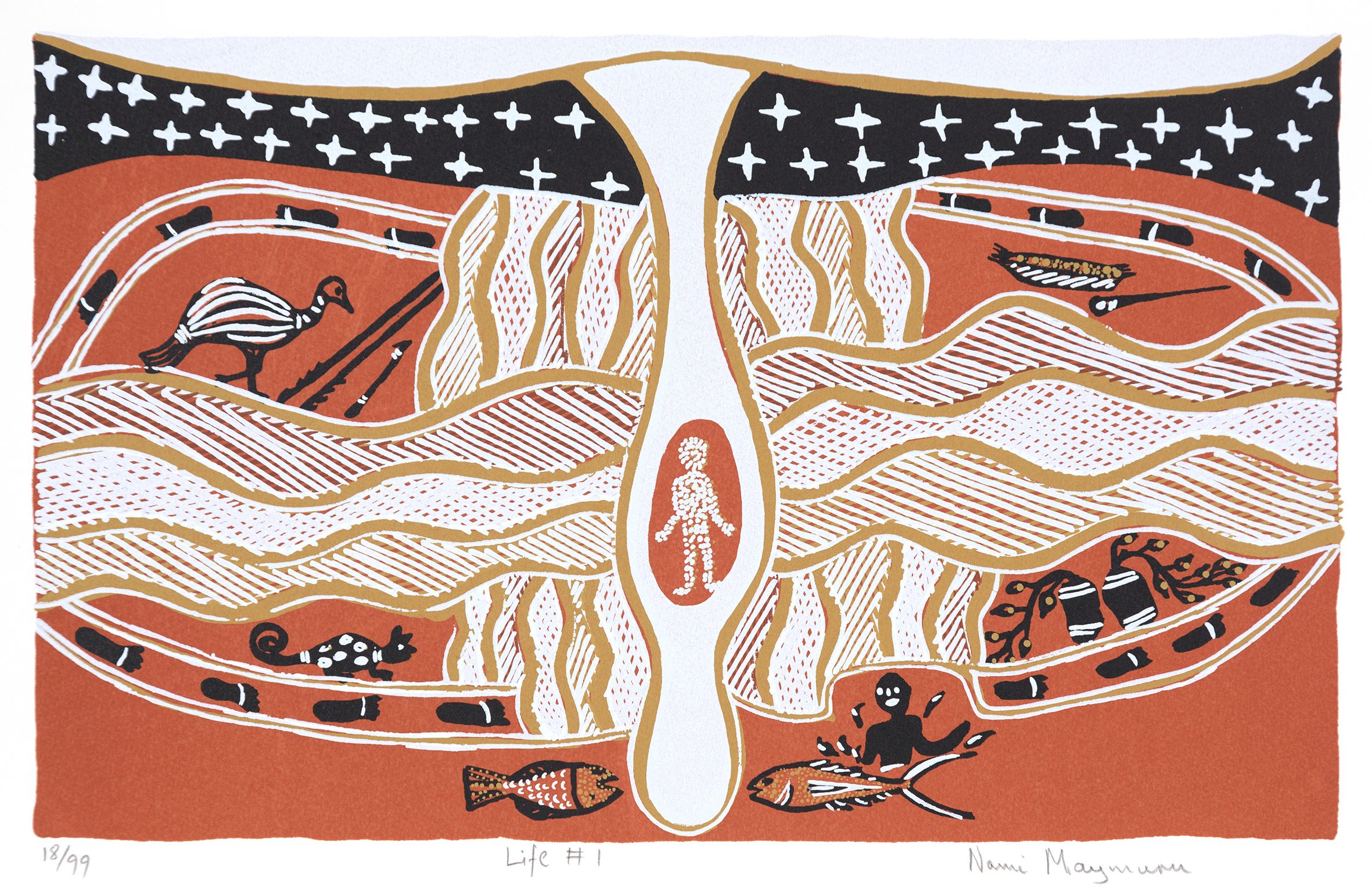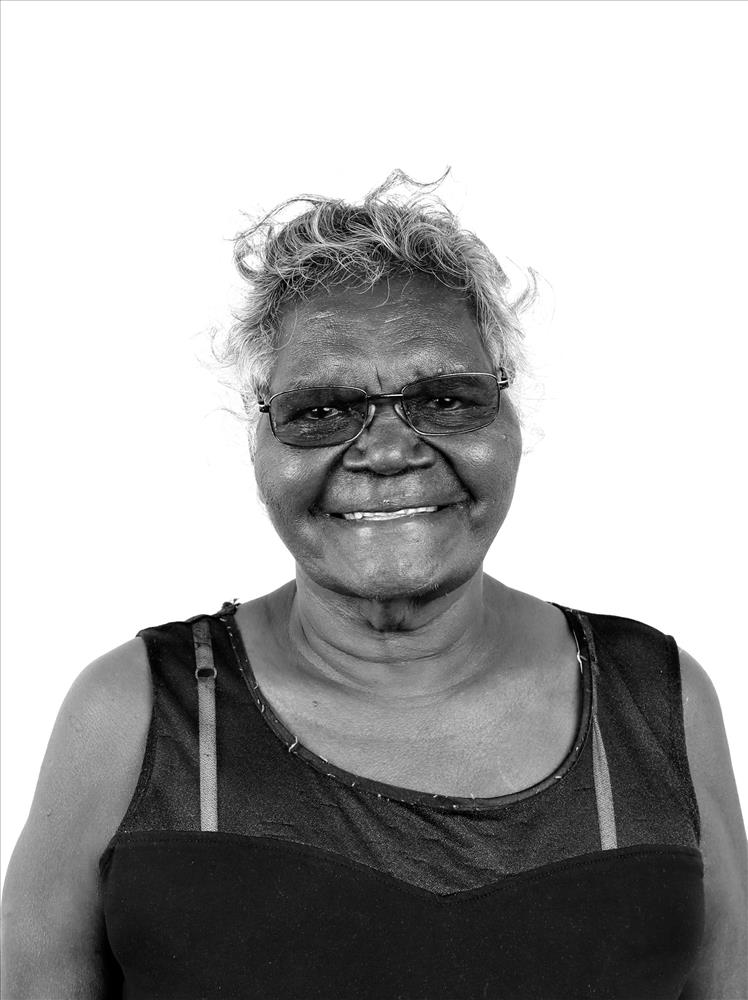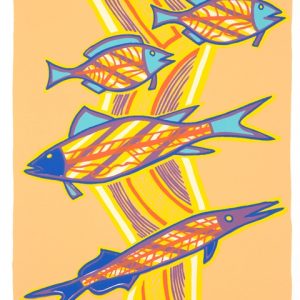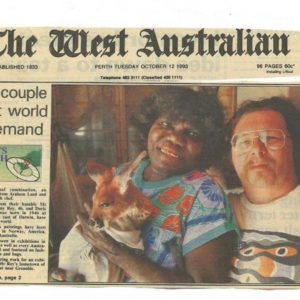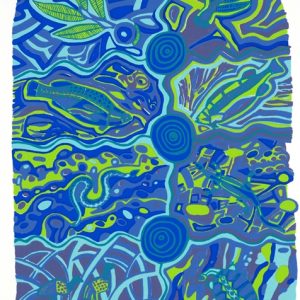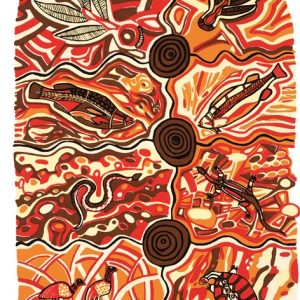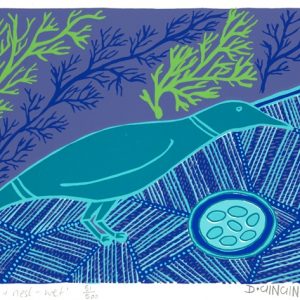Description
Apologies for the low quality image. We hope to have a better one soon. Contact us if you are interested.
Artist: Nampinapu Maymuru-White
- Language Group: Mangalili/Yolngu Matha
- Region: NE Arnhem Land, NT
- Born: 1952
Story
In this print the artist has depicted the child’s spirit coming down from the spirit world, Milngiyawuy in the sky, which is known in English as the Milky Way. It is traveling through the Wayala (path) going down towards Wayawu, which is a Mangalili language group country that was given to them by their ancestral being in the ‘Dreaming’ (ancestral creation time). When the child’s spirit reaches Wayawu, it goes into the river and transforms into certain kinds of Yirritja moiety animals or fish. These animals and fish are totems of the Mangalili group. The animals and fish are hunted by people closely related to the child’s father, either his brothers or sisters. They are given to the people as a gift by the spirit of the child. The child’s spirit drives the animals and fish to the hunters, and it is said that they seem to give their lives up with little resistance. The food is shared by the child’s family, according to the law. The child is emerging from the river as a human, and explores the world, so a new life begins. The baby is presented to the family and is celebrated. The child is guided and directed through his or her life journey and the mother fulfills her responsibilities to the baby. This relationship continues until the child is able to look after itself and eventually fulfills its responsibilities to the mother. The relationship of mother and child is reciprocity, and is equal and interdependent.
This print is one of a pair – the story continues in the second print: Life #2 (Ceremonial Ground)
Artist Biography
Naminapu’s major interest is her art. She is an extremely versatile artist with skills in the areas of painting, carving, screen-printing, weaving, lino-cuts and batik work. As a child she used to sit for hours patiently watching her father paint. At about the age of 12, she began to learn herself, and was fortunate in being taught by her father’s brother, Narritjin Maymuru, as well as by her own father, Nånyin Maymuru. Both men were extremely able and well-known artists, whose works hang in many Australian and overseas museums. As one of the first Yolŋu women to be taught to paint miny’tji (sacred creation clan designs) she was part of the historic adaptations by the elders of the Yolŋu in the last forty years which included the revelation of previously restricted designs in pursuit of justice in the Land Rights struggle (for example The Bark Petition and The Yirrkala Church Panels).
Naminapu Maymuru was born a member of the Mangalili clan, at the Yirrkala mission station in Northeast Arnhem Land in Northern Australia in 1952. After attending the mission school, she worked for some time in the store and craft shop and also helped out in the local bank. When the Homeland Centre of Gurka’wuy was established in 1973, Naminapu went to live there with her husband and young family of three children. These were the early days of the Homeland Movement, which included the establishment by Narritjin of the Mangalili homeland of Djarrakpi (extensively documented by Ian Dunlop of Film Australia in the twenty two films of the Yirrkala Film Project). During the years she spent there, Naminapu worked as a teacher trainee and later, on her return to Yirrkala, completed her teacher training. When she later married Leon White, a teacher in the Northern Territory, Naminapu went to live for several years in Melbourne and Darwin.
She has travelled within Australia quite extensively as well as to Japan. In 1985, Naminapu returned with her husband and family to live in Yirrkala, now no longer a mission station but a locally governed Aboriginal community. Following her return, she taught art to the children at the local school and then began working at the Craft Shop attached to the Buku-Larrnggay Arts Centre. In 1990, she was appointed Curator of the recently established Art Museum attached to this Centre, a position that she held until 1996.
Naminapu’s works were exhibited very successfully with those of Banduk Marika, another Yirrkala woman artist, at a ‘dual’ exhibition held in Warnambool and Sydney, in 1990. Her works are also frequently included in combined exhibitions in Australia and overseas and she is now herself represented in most major institutional collections in the country. In August 1996 at the 13th Telstra National Aboriginal and Islander Art Awards her limited edition linoprint triptych “Nyapilingu” was chosen as the ‘Best Work on Paper’. In 1998 she was selected as the National Indigenous Heritage Art Award Joint Runner-up Normandy Art Award (for her bark “Maŋgalili”) One of her memorial poles with the Milŋiyawuy or milky way design won the Wandjuk Marika Memorial 3D award at the 2005 Telstra National Aboriginal and Torres Strait Islander Art Awards.
First Nations Fertility prints
This is one of a range of 14 limited edition screen-prints on paper exclusively available through Songlines. The prints have not been exhibited or offered for sale since 1999, the year they were created by eight Indigenous Australian women artists. Images of the prints were used as slides by Fay Nelson, then Director Aboriginal Arts Board, Australia Council, in her keynote address at the landmark Sydney IVF Fertility Conference held at Darling Harbour Conference Centre.
The prints and Dr Nelson’s essay ‘Aboriginal Fertility’ are documented in the conference proceedings published as Towards Reproductive Certainty – Fertility and Genetics beyond 1999 edited by Robert Jansen and David Mortimer with the assistance of Karen Coote, published by The Parthenon Publishing Group.
Provenance: Karen Coote (who commissioned the Fertility Prints from participating artists)

